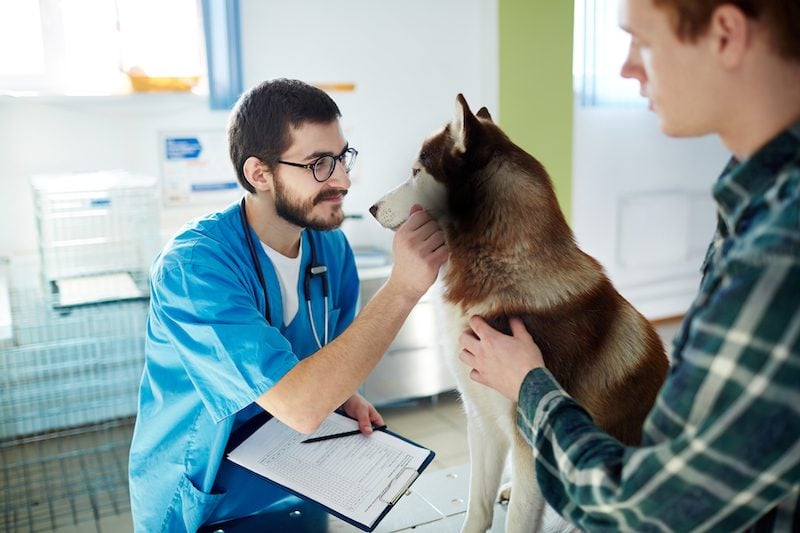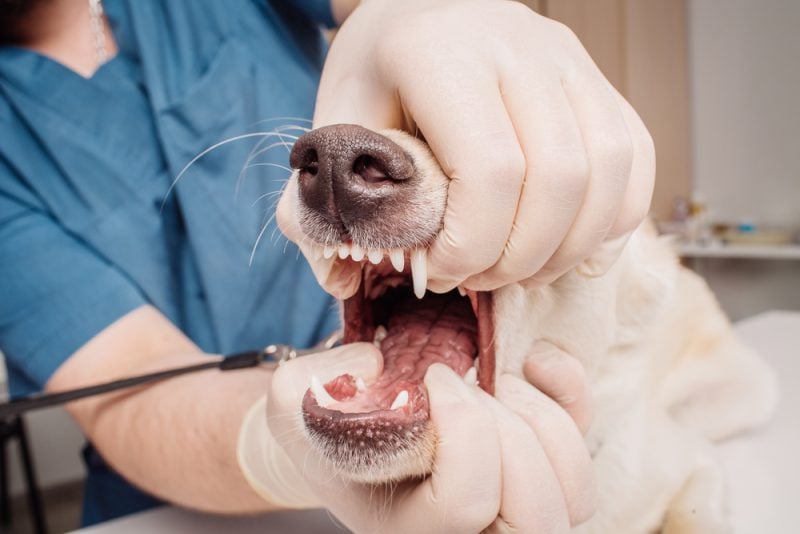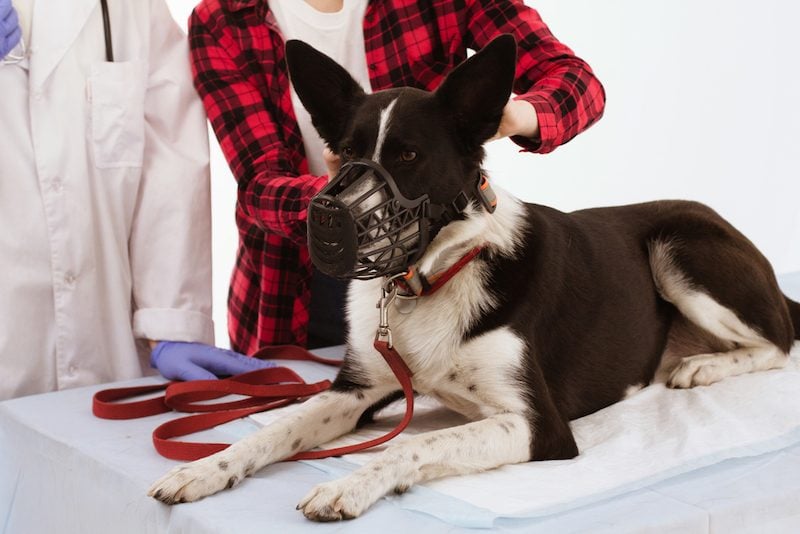No matter what kind of dog you have, or how well you care for her, she’ll need to go to the vet from time to time.
She’ll not only need vaccinations, but she’ll also need routine treatment for things like parasites, as well as checkups and dental cleanings.
But this causes many owners – particularly new owners – a bit of anxiety, as they wonder about the costs associated with these services. After all, there are roughly 135 million cats and dogs in the U.S., and pet owners spent $16 billion and change on veterinary services in 2017 to care for them.
That’s a lot of money spent at the vet’s office!
It is true that some vet visits can end up costing quite a bit of money, but this isn’t always the case.
Some vet visits will turn out to be pretty affordable, and there are even a few things you can do to reduce the amount of money you spend on your pet’s care, without compromising her health and well-being.
We’ll talk about all of these issues and more below.
Average Prices: How Much Is a Vet Visit for a Dog?
To go ahead and address the central question, you’ll likely spend about $50 to $100 for a typical visit.

But don’t stop reading yet, because there are a lot of caveats and details to discuss. In practice, veterinary costs – even for cookie-cutter things like a routine visit – vary greatly.
Your vet may charge $50 for a standard examination, while your friend’s vet will charge twice as much. For that matter, you could easily find two different members of the same national chain charging different prices.
Consequently, it is pretty tough to estimate the average cost of a veterinary visit. You’ll just have to pick up the phone and call around, as relatively few vets publish their fee structures online.
With that said, one national chain – Banfield Pet Hospitals – does publish their basic fee structure.
I plugged in a few different cities (actually, zip codes) to determine the average pricing for a basic office visit. Obviously, these figures are subject to change, and the following table is for informational purposes only, but it should be pretty helpful.
Just consider these prices a rough guide.
| City | Price for a Routing Visit |
| Atlanta, Georgia | $45.95 |
| New York, New York | $59.95 |
| Los Angeles, California | $54.95 |
| Austin, Texas | $45.95 |
| Denver, Colorado | $47.95 |
| Chicago, Illinois | $50.95 |
| Seattle, Washington | $54.95 |
| Mobile, Alabama | $44.95 |
| South Bend, Indiana | $50.95 |
| Fargo, North Dakota | $47.95 |
I tried to pick a collection of cities that spanned the cost-of-living spectrum, as location is often a significant factor involved with vet pricing. But interestingly, Banfield’s fees don’t really vary by that much.
New Yorkers will pay 60 bucks for a standard office visit, while owners in South Bend will pay a bit more than $50.
Keep in mind that these figures only include the office visit.
Things like diagnostic tests, dog x-rays, procedures, and medications will all increase the amount you spend. You’ll spend less on routine visits than surgical procedures or complicated laboratory tests.
But the table above only covers one vet chain. To get a better idea of the price range, we’ll have to look at more comprehensive data.
According to a 2017-2018 survey conducted by the American Pet Products Association, dog owners spent an average of $257 for routine services over the course of a year. The same study found that owners typically spent an average of $474 on surgical visits in a given year.
If you assume the average pet would visit the vet twice or thrice a year, this means you’d be looking at about $85 to $128 per routine visit.
Note that, while it isn’t entirely clear, it appears that these costs included things like vaccinations, worming medications, and other common medications and treatments.
We found a few other estimates in various places:
- Wellness Pet Foods suggests that the average cost of a physical exam is $45 to $55, but they don’t explain how they arrived at this figure. Nevertheless, it is in line with most other reports.
- CareCredit also provides some unsourced estimates. We’d normally be inclined to discount their figures, as their business model involves financing veterinary services (among other things), so they aren’t exactly an unbiased source. But their estimate for an office call — $45 to $55 – is right in line with most others.
- PetPlus, a general pet information site, lists the average cost for an office call at the same price as the others — $45 to $55. However, like most of the other sources we found, they don’t explain how they arrived at this figure.
How Much Do Common Veterinary Treatments Cost?
As you can see, the cost for a typical office visit is usually pretty reasonable. However, this will rarely represent the total cost – you’ll frequently need to pay for additional services the vet or staff provides during the visit. We’ll discuss a few of the most common services below.
How Much Does a General Dog Checkup Cost?
A general checkup will usually cost about the same as a standard office visit – some vets won’t even distinguish between the two services. So, you’ll likely spend about $40 to $60.

How Much Do Dog Vaccinations Cost?
Young puppies need a series of vaccinations over their first year, and adults will need periodic boosters throughout their lives.
The exact combination of puppy vaccinations your vet recommends will vary based on a variety of factors, but the following are considered “core vaccines,” which almost all dogs require:
- Canine parvovirus
- Canine distemper
- Canine parainfluenza
- Canine adenovirus-1 (hepatitis)
- Canine adenovirus-2
- Rabies
As with all other veterinary services, the costs for your dog’s vaccines will vary. However, you’ll usually end up spending between $60 and $120 for the first year of vaccines, and about $50 to $60 in subsequent years.
Be sure to check out our article on puppy vaccinations to learn more about the specific vaccines your vet may recommend and what to expect during this time.
How Much Do Dental Cleanings Cost?
Unfortunately, dental cleanings are usually pretty expensive.
This is primarily because anesthesia is almost always required, and the work is often time-consuming. If your dog is young, healthy and free of any significant dental problems, you’ll probably be looking at spending $200 to $300.

However, if your dog has any health concerns, is of advanced age, or has serious oral health issues, you may end up paying $1,000 or more to get your pup’s teeth taken care of.
We’ve written about the cost of dog dental cleanings in greater detail if you’d like to learn a little more about the process and costs involved.
How Much Do Dog Spaying and Neutering Cost?
The costs for spaying and neutering vary wildly from one vet or clinic to the next. They also vary based on your dog’s breed, size, age, and health status.
You may be able to find a low-cost clinic that will neuter your pup for about $50 (spay operations, being considerably more complicated will usually cost at least twice or thrice as much).
Shelters will often offer free or very discounted spaying and neutering services on certain days, but the wait for these procedures can be long since so many people arrive to take advantage of the free treatment.
On the other hand, you may end up paying $800 or more to have your regular vet perform the same procedure on a mature dog with a few health problems. The advantage is that you won’t have to wait in line for hours!
If you need to find low-cost spaying or neutering services, check out this resource, maintained by the ASPCA.
How Much Do Dog Heartworm Tests Cost?
Heartworm tests are an important medical procedure, which most vets will recommend conducting annually.
A heartworm test requires your vet to collect a blood sample and then send it off for laboratory testing. Heartworm disease is very serious, so this isn’t something to take lightly or try to skip in an effort to reduce your costs.
Fortunately, heartworm testing isn’t terribly expensive – it’ll usually cost about $50.
How Much Do Dog Fecal Examinations Cost?
Fecal examinations are helpful for determining if your dog is infested with hookworms, whipworms, or other internal parasites. There are a few different types of fecal examinations vets use – some simply require a doctor to take a swab of your pet’s rectum, while others require you to collect a small amount of your pet’s poop for laboratory analysis.
Some vets will recommend doing fecal examinations routinely (perhaps once per year), while others will only recommend them when there is some reason to believe your dog is harboring parasites.
In most cases, fecal examinations are relatively affordable. They usually cost about $25 to $50.
Factors That Affect the Cost of Veterinary Services
Vets charge different rates for a number of different reasons, but a few of the most noteworthy include the following:
Location
Like many other goods and services, veterinary services vary geographically. Generally speaking, the higher the cost of living in your area, the more the local vets must charge. So, you should expect to pay more for vet services in Beverly Hills than a more affordable mid-western city.
But interestingly, while this is generally true, there’s a bit of peculiar data on the subject out there. For example, Petplan Pet Insurance reports that pet owners in New Mexico and Louisiana – two relatively affordable states — pay more in veterinary expenses than owners in relatively pricey places like New York or Massachusetts do.
The reasons for this aren’t exactly clear. Perhaps people in New Mexico own more dogs on average than those in New York. Or perhaps dogs in Louisiana are more likely to get into mischief than their counterparts in Massachusetts.
Your Dog’s Temperament
No matter what your vet’s typical price structure is, you may find yourself paying more for services if your dog is aggressive or otherwise difficult during visits. This is true for many dog related services – for example, you’ll likely pay more at the groomer too if your dog is a trouble-maker.
Aggressive or uncooperative dogs may require a vet to use muzzles or other types of restraints or enlist the help of additional staff – all of which will increase the cost of the visit.
This is one of the many reasons it is important to visit your vet regularly while your pup is young, as it’ll often help her learn that visits are normal and no cause for worry.

The Nature of the Visit (Pre-Planned or Emergency)
In most cases, you’ll spend less money on a routine, pre-planned visit than you will if you have to take your dog in after hours or on an emergency basis.
Vets have to go to a lot of trouble to fit in unexpected clients, and they may have to drop what they’re doing in their personal lives and come into the office if you need an emergency appointment.
You obviously can’t avoid all emergencies, but regular checkups will help eliminate the need for some. Also, just be careful with your pooch – always consider the potential for injury when you’re playing with your pup.
Who Owns the Vet Clinic
More and more vet clinics are being purchased by private equity firms, whose sole purpose is to create revenue for its members. As a result, clinics owned by private equity firms may dramatically increase pricing across a variety of services in hopes of bolstering revenue.
Different Vets Embrace Different Business Models
Just like any other type of business, different vets embrace different business models.
Some charge higher rates, while treating fewer clients, and others take the opposite approach. Some keep their prices high yet throw in plenty of free or reduced-cost “extras,” whereas others don’t charge as much for their procedures, yet they make sure every little service provided appears on your bill.
This is actually quite helpful for dog owners, as it gives you a lot of different options. Some will choose to spare no expense while seeking veterinary care, and others will need to do everything possible to limit the bills incurred, but most dog owners probably fall somewhere in the middle.
Tips and Tricks for Saving Money at the Vet
Veterinary care will represent a significant portion of the total expenses you’ll incur as a dog owner. There’s simply no way to get around that. But there are a few effective strategies and tricks that’ll help you save money in some cases. We’ll talk about a few of the most noteworthy below.

Pet Insurance Plans
Pet insurance plans are a good way for some owners to save money on their pet’s veterinary care, but they’ll only produce modest savings for others. In some cases, you may spend more on a yearly pet insurance plan than you do at the vet.
Most pet insurance plans work by refunding some percentage of your veterinary care costs. You’ll usually have to pay the full amount up-front and then wait for a reimbursement check in the mail.
Different plans cover different services, some may only cover a certain number of x-ray treatments, and some are only valid at specific vets.
You’ll just have to sit down, crunch the numbers, look the plan over thoroughly, and make the best decision you can. We’ll be reviewing some of the best pet insurance plans in the future, so stay tuned.
You can also check out Consumer Advocate’s super in-depth guide to various pet insurance plans, which helps show which plans cover what.
Veterinary Care Discount Programs
Discount programs are often similar to pet insurance plans; in fact, some insurance plans are basically discount programs masquerading as insurance plans.
Essentially, the companies that manage these types of plans work out deals with participating vets. They send the vets clients, and the vet gives those clients a discount in exchange.
As with pet insurance plans, discount programs vary, so you’ll just have to carefully consider each plan. We did a full Pet Assure review, so be sure to check out that guide if you’re considering a veterinary care discount program.
Direct Negotiations with Vets and Discussions
It never hurts to talk with your vet and let him or her know that money’s a little tight.
Some vets won’t be willing or able to do anything to help, but others may. Some may allow you to split up payments over time, and others may provide discounted services.
Just be honest, and make sure that you are respectful once you get an answer. Most vets entered the career in order to help pets – not to get rich. But that doesn’t mean they don’t have bills and overhead of their own, and they can’t give away their services for free.
It’s also worth pointing out that a lot of veterinarians offer discounts to new clients. So, be sure to ask when you are shopping around.
On the flipside, many vets will also offer discounts for their long-time clients or provide small services for free.
Tap into Your Social Network
One of the best ways to save money on vet fees is to hit Facebook, Twitter, Reddit, or whatever social media platform you prefer, and ask your friends and acquaintances if they can recommend an affordable vet.
Some people may even be able to share helpful info that isn’t publicly available.
Watch for Low-Cost Clinics
From time to time, veterinary schools, shelters, and other dog-related organizations offer low-cost clinics. These types of events usually happen on weekends, and they offer things like vaccinations for reduced rates.
It’s hard to plan for these types of events, so the best thing to do is keep your eyes open and take advantage of them as they occur.
You’ll still need to obtain services from your regular vet from time to time, but discount clinics should help you reduce your overall expenditures a bit. Also research any local organizations that help pay for vet bills of those with financial need.
Address Small Issues Promptly
To the extent possible, try to address small problems promptly, as it’ll often help prevent them from becoming big (read: expensive) problems. This is not only better for your pet’s health and well-being, but it’ll help you save tons of money in the long run.
So, don’t wait a month for your dog’s hot spot to go away or cut corners while trying to treat your dog’s flea problem. Go to your vet and get your furry one’s problems treated while it’s easy to do so.
Consider Consulting With a Veterinarian Virtually
In some cases, you may not even need a proper veterinary visit – you may just need some advice from a knowledgeable vet. In these cases, a digital consult with a vet might do the trick.
In recent years, dozens of online virtual vet services have popped up, allowing you quick and easy access to a veterinarian consult without requiring you to drag your pooch into a vet’s office. Some of these digital services can even help you get your pet a perscription online!
For a small fee (which can vary from a one-time fee to a monthly membership), you’ll have the chance to discuss your dog’s issue with a veterinarian. You may still end up needing to go to your vet, but in some cases, you’ll be able to avoid a costly and unnecessary visit.
Veterinary Cost FAQs
Because vets often charge very different rates, and the entire process of going to the vet can be a bit overwhelming at times, many owners have questions about the issue.
We’ll try to answer some of the most common questions owners have below.
How do you find free vet clinics near your home?
From time to time, local non-profit organizations and veterinarians will provide low-cost or free clinics. These types of clinics can be incredibly helpful for budget-limited owners, but you’ll often have to do some digging to find any in your area.
The best way to locate these types of clinics is by a simple internet search, but you may also have success by calling local shelters or vet offices.
How can you find low income veterinary care?
Like free clinics, some vets and non-profits offer veterinary services for low-income owners. There’s unfortunately no easy way to track these down, you’ll just have to work your phone and search the internet for promising leads.
How much does an emergency vet visit cost?
As with regular veterinary visits, the costs associated with emergency vet visits will vary. However, you will almost always have to spend more for an emergency visit than a pre-scheduled, non-emergency visit.
As a ballpark figure, you’ll likely have to spend about $100 for the visit. However, this won’t include any major services or procedures – these will all involve additional costs.
Why dog vets charge so much?
Veterinary care can be expensive, which leaves a bad taste in the mouths of many owners. But it’s important to note that most vets decide to work in the field because they want to help animals, not as a way to finance a yacht.
There are a few reasons veterinary care seems expensive. For one, many people compare it to human health care, but they neglect to consider the fact that most people have health insurance, which helps to drastically reduce the fees associated with some services.
Additionally, it is important to understand all of the “behind the scenes” things that the average vet clinic has to pay for. This includes everything from rent and staff salaries to medical equipment and diagnostic tools. These things are all expensive, and vets have to charge enough money to offset these liabilities.
So, resist the urge to think that your vet is price gouging – in most cases, he or she is just trying to treat your pet while being able to afford to keep the lights on.
Want to learn more about veterinarians? Check out 32 Fascinating Veterinary Statistics!
***
There’s no getting around the fact that veterinary care is, at times, expensive. But it’s a simple fact of life for pet owners.
To put it bluntly, if you welcome a bundle of four-footed joy into your family, you’ll need to do whatever necessary to provide your pet with the type of care you’d want for yourself or a two-legged loved one.
I know first-hand how financially challenging it can be to suddenly find yourself faced with a bill for veterinary services that you simply cannot afford.
Nearly twenty years ago, I found myself in an emergency veterinary clinic, begging the receptionist to split my pup’s surgery bill across five different credit cards. She obliged, and my pup turned out fine in the long-run.
But unfortunately, and despite the efforts of several dedicated and highly trained professionals, my credit score could not be saved.
Point being, I certainly don’t mean to be preachy or judgmental about any of this. But, it’s important to value the joy our dogs bring to our lives, and make sure that you are properly prepared to handle both regular veterinary care, as well as any unforeseen expenses that may arise.
With all of that said, we hope that this has helped you understand what to expect from a run-of-the-mill veterinary visit. This way, you can plan ahead and be sure to budget appropriately for your floof. Take advantage of the tips provided above too – every little bit helps.
We’d love to hear about your vet bills!
You don’t have to share the actual figures if you don’t want to, but we’d just be interested in knowing about your overall thoughts on the matter.
Do you think your vet bills are too high? Are they about what you’d expect? Do you shop around to find the vet with the best prices, or do you prioritize other things?
Let us know in the comments below!














Leave a Comment